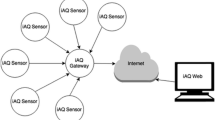Abstract
An indoor air quality monitoring system helps in the detection and improvement of indoor air quality. The monitoring systems presently available are very expensive. In this paper, we present a low-cost indoor air quality monitoring wireless sensor network system developed using Arduino, XBee modules, and micro gas sensors. The system is capable of collecting six air quality parameters from different locations simultaneously. We have also developed a linear least square estimation-based method for sensor calibration and measurement data conversion. In this paper, we present the detailed design of wireless air quality sensor node and the calibration method. The performance and usefulness of the system are demonstrated by comparing measurement results of our system with a professional-grade air quality measurement device.











Similar content being viewed by others
References
US Environmental Protection Agency (USEPA). Indoor air quality tools for schools Communications guide. Available at http://www.epa.gov.
H.S. Brightman and N. Moss. Sick building syndrome studies and the compilation of normative and comparative values. Indoor Air Quality Handbook. Editors: J. D. Spengler, J. F. McCarthy, and J. M. Samet, New York: McGraw-Hill, 2001.
Ying Han; Neng Zhu; Nan Lu; Jing Chen; Yan Ding, “The Sources and Health Impacts of Indoor Air Pollution,” International Conference on Bioinformatics and Biomedical Engineering (ICBBE), June 2010.
Occupational Health and Safety Administration, “Indoor Air Quality in Commercial and Institutional Buildings”, available at https://www.osha.gov/Publications/3430indoor-air-quality-sm.
S. Choi, N. Kim, H. Cha and R. Ha, “Micro Sensor Node for Air Pollutant Monitoring: Hardware and Software Issues”, Sensors, No. 9, 2009.
J.-J. Kim, S.K. Jung, and J.T. Kim. Wireless monitoring of indoor air quality by a sensor network. Indoor and Built Environment, 19:1:145–150, 2010.
R. Wan and D. Kong, “Analysis on Influencing Factors of Indoor Air Quality and Measures of Improvement on Modern Buildings,” The 2nd International Conference on Bioinformatics and Biomedical Engineering, May 2008.
S. Bhattacharya, S. Sridevi, R. Pitchiah, “Indoor air quality monitoring using wireless sensor network,” Sixth International Conference on Sensing Technology (ICST), Dec. 2012.
V. Jelicic, M. Magno, G. Paci, D. Brunelli, L. Benini, “Design, characterization and management of a wireless sensor network for smart gas monitoring,” IEEE International Workshop on Advances in Sensors and Interfaces (IWASI), June 2011.
Sherin Abraham and Xinrong Li, “A cost-effective wireless sensor network system for indoor air quality monitoring applications,” The 9th International Conference on Future Networks and Communications (FNC), Niagara Falls, Ontario, Canada, August 2014.
J. Yang, C. Zhang, X. Li, Y. Huang, S. Fu, M.F. Acevedo. Integration of wireless sensor networks in environmental monitoring cyber infrastructure. Wireless Networks, Springer/ACM, Volume 16, Issue 4, pp. 1091–1108, May 2010.
S. Ferdoush and X. Li, “Wireless sensor network system design using Raspberry Pi and Arduino for environmental monitoring applications,” The 9th International Conference on Future Networks and Communications (FNC), Niagara Falls, Ontario, Canada, August 2014.
Digi International Inc., available at http://www.digi.com/
IEEE 802.15 WPAN Task Group 4 (TG4), available at http://www.ieee802.org/15/pub/TG4.html
ZigBee Alliance, available at http://www.zigbee.org/
Carbon Dioxide Sensor MG811 Datasheet, available at http://www.olimex.cl/pdf/CO2b
Operational Amplifier MCP6001 Datasheet, available at http://ww1.microchip.com/downloads/en/DeviceDoc/21733h
Volatile Organic Compounds Sensor TGS2602 Datasheet, available at http://www.figarosensor.com/products/2602pdf
Carbon Monoxide Sensor MG7 Datasheet, available at https://www.sparkfun.com/datasheets/Sensors/Biometric/MQ-7
Ozone Sensor MQ131 Datasheet, available at http://www.winsensor.com
IHS GlobalSpec. Laboratory and Calibration Gases Information. available at http://www.globalspec.com/learnmore/materials_chemicals_adhesives/industrial_specialty_gases/laboratory_calibration_gases
Direct Sense IAQ 610, GrayWolf Sensing Solutions, available at http://www.wolfsense.com/
S. M. Kay, Fundamentals of Statistical Signal Processing, Vol.1: Estimation theory, Prentice Hall, 1993.
S. Abraham. Development of cost effective wireless sensor system for indoor air quality monitoring applications. Master of Science Thesis, University of North Texas, 2014.
Temperature and Humidity Sensor RTH03 Datasheet, available at http://dlnmh9ip6v2uc.cloudfront.net/datasheets/Sensors/Weather/RHT03
Author information
Authors and Affiliations
Corresponding author
Rights and permissions
About this article
Cite this article
Abraham, S., Li, X. Design of A Low-Cost Wireless Indoor Air Quality Sensor Network System. Int J Wireless Inf Networks 23, 57–65 (2016). https://doi.org/10.1007/s10776-016-0299-y
Received:
Accepted:
Published:
Issue Date:
DOI: https://doi.org/10.1007/s10776-016-0299-y




